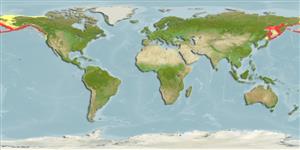>
Pleuronectiformes (Flatfishes) >
Pleuronectidae (Righteye flounders) > Hippoglossinae
Etymology: Hippoglossus: Greek, ippos = horse + Greek, glossa = tongue (Ref. 45335); stenolepis: From the Greek hippos (horse), glossa (tounge), steno (narrow), lepis, (scale). In 1904, a Russian scientist by the name of P.J. Schmidt first proposed the scientific name based on anatomical differences such as scale shape, pectoral fin length, and body shape which he thought distinguished it from the Atlantic halibut (Hippoglossus hippoglossus). (Ref. 94075).
Environment: milieu / climate zone / intervalo de profundidade / distribution range
Ecologia
marinhas demersal; oceanódromo (Ref. 51243); intervalo de profundidade 0 - 1200 m (Ref. 50550). Temperate; 73°N - 42°N, 138°E - 123°W (Ref. 54557)
North Pacific: Hokkaido, Japan and the Sea of Okhotsk to the southern Chukchi Sea and Point Camalu, Baja California, Mexico.
Length at first maturity / Tamanho / Peso / Idade
Maturidade: Lm ? range ? - ? cm
Max length : 258 cm TL macho/indeterminado; (Ref. 40637); 267.0 cm TL (female); peso máx. Publicado: 363.0 kg (Ref. ); Idade máx. registada: 55 anos (Ref. 55701)
Descrição breve
Chaves de identificação | Morfologia | Morfometria
Espinhos dorsais (total) : 0; Raios dorsais moles (total) : 90 - 106; Espinhos anais: 0; Raios anais moles: 69 - 80; Vértebras: 49 - 51. Dorsal origin above anterior part of pupil in upper eye, generally low, higher in middle. Caudal spread and slightly lunate. Pectorals small.
Body shape (shape guide): fusiform / normal.
Found on various types of bottoms (Ref. 2850). Young are found near shore, moving out to deeper waters as they grow older (Ref. 6885). Older individuals typically move from deeper water along the edge of the continental shelf where they spend the winter, to shallow coastal water (27-274 m) for the summer (Ref. 28499). Feed on fishes, crabs, clams, squids, and other invertebrates (Ref. 6885). Utilized fresh, dried or salted, smoked and frozen; eaten steamed, fried, broiled, boiled, microwaved and baked (Ref. 9988).
Vinnikov, K.A., R.C. Thomson and T.A. Munroe, 2018. Revised classification of the righteye flounders (Teleostei: Pleuronectidae) based on multilocus phylogeny with complete taxon sampling. Molecular phylogenetics and evolution, 125:147-162. (Ref. 122998)
Categoria na Lista Vermelha da IUCN (Ref. 130435: Version 2025-1)
Ameaça para o homem
Harmless
Utilização humana
Pescarias: altamente comercial; peixe desportivo: sim; Aquário: Aquários públicos
Ferramentas
Relatórios especiais
Descarregue XML
Fontes da internet
Estimates based on models
Preferred temperature (Ref.
123201): 0.3 - 5.7, mean 1.6 °C (based on 454 cells).
Phylogenetic diversity index (Ref.
82804): PD
50 = 0.7500 [Uniqueness, from 0.5 = low to 2.0 = high].
Bayesian length-weight: a=0.00631 (0.00400 - 0.00995), b=3.14 (3.00 - 3.28), in cm total length, based on LWR estimates for this species & (Sub)family-body (Ref.
93245).
Nível Trófico (Ref.
69278): 4.1 ±0.2 se; based on diet studies.
Resiliência (Ref.
120179): Muito baixo, tempo mínimo de duplicação da população maior que 14 anos (rm=0.2; K=0.05; tm=5-20; tmax=55).
Prior r = 0.11, 95% CL = 0.07 - 0.17, Based on 3 full stock assessments.
Fishing Vulnerability (Ref.
59153): Very high vulnerability (86 of 100).
🛈
Climate Vulnerability (Ref.
125649): Moderate to high vulnerability (45 of 100).
🛈
Nutrients (Ref.
124155): Calcium = 8.89 [2.92, 21.69] mg/100g; Iron = 0.202 [0.078, 0.561] mg/100g; Protein = 18 [16, 20] %; Omega3 = 0.391 [0.169, 0.895] g/100g; Selenium = 42.3 [14.7, 110.0] μg/100g; VitaminA = 10.8 [2.5, 41.8] μg/100g; Zinc = 0.412 [0.179, 0.699] mg/100g (wet weight);
